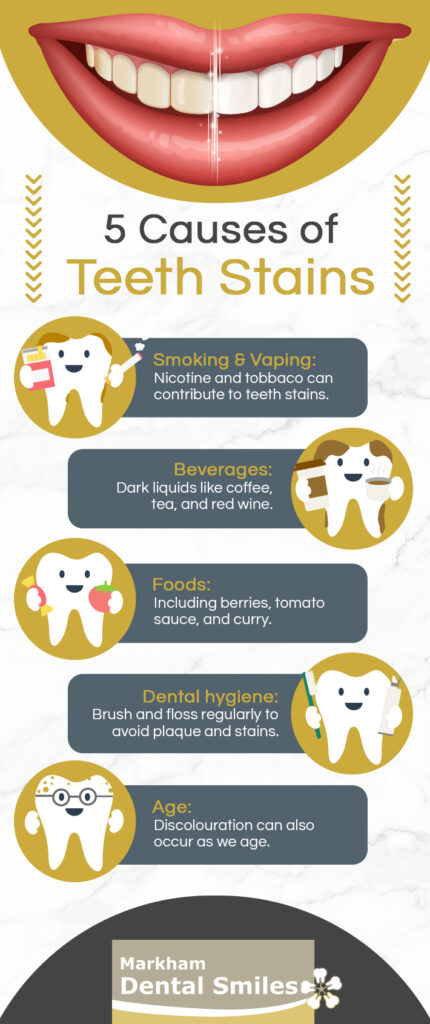A beautiful smile is a crucial part of our social interactions, and having perfect teeth is the dream of many. Unfortunately, teeth can be easily stained by the foods we eat, beverages we drink, or our lifestyle habits.
Teeth stains can range from mildly yellow to dark brown, impacting our self-esteem and overall dental health. The good news is that there are ways to prevent and remove tooth stains, regardless of their cause.
Stains can occur on the outside (extrinsic stains) and inside (intrinsic stains) of our teeth. These stains can be addressed by over-the-counter measures or whitening services provided by your dentist.
Types of Teeth Stains
Teeth stains can be classified into 3 categories: extrinsic, intrinsic, and age-related.
Extrinsic teeth stains occur on the surface of the teeth and are triggered by external factors, while intrinsic teeth stains occur inside the teeth and are caused by internal factors. Your teeth can also develop stains as you age.
Extrinsic Teeth Stains
Extrinsic teeth stains are usually caused by the foods, beverages we drink, or lifestyle habits.
The most common culprits are coffee, tea, red wine, cola, sports drinks, tomato sauce, soy sauce, berries, smoking, and poor dental hygiene. Extrinsic teeth stains can usually be avoided and reduced by good oral health practices such as brushing and flossing regularly, avoiding staining foods and beverages, and using teeth whitening products.
Intrinsic Teeth Stains
Intrinsic teeth stains are harder to remove because they occur inside the teeth and can be triggered by genetic, medical, or environmental factors.
Intrinsic teeth stains can be yellow, brown, or gray and can be caused by excessive fluoride exposure, tooth trauma, tetracycline medication, or aging. Intrinsic teeth stains require professional dental treatment, such as teeth whitening.
Age-Related Teeth Stains
Our teeth naturally become dull and discoloured as we age due to years of wear and tear and exposure to different substances. Age-related teeth stains are a combination of extrinsic and intrinsic and can be challenging to remove.

Causes of Teeth Stains
Various factors, including lifestyle habits, genetics, and dental hygiene, cause teeth stains. Here are some of the most common causes of teeth stains:
1. Smoking and Vaping: Smoking can contribute to teeth stains, as it contains tar and nicotine that can stain the teeth. Vaping fluid that contains nicotine can also stain your teeth.
2. Beverages: Beverages such as coffee, tea, and red wine contain bacteria that can stain the teeth.
3. Foods: Certain foods like berries and tomato sauce contain pigments that can cause teeth stains.
4. Poor dental hygiene: Poor dental hygiene habits like not brushing or flossing regularly can cause plaque buildup and teeth stains.
5. Age: Our teeth can naturally become yellow or gray due to the wear and tear of the enamel and dentin layers.
How to Whiten Teeth?
While many over-the-counter products can help reduce the appearance of surface stains on your teeth, your dentist can provide whitening services to address more prevalent staining.
At-Home Whitening
One of the most common methods of teeth whitening is at-home treatments. You can purchase several over-the-counter products, such as whitening strips or gels, that can help reduce the appearance of surface stains.
However, these products are not always as effective as professional-grade options, as they often use less potent ingredients and can’t be personalized to your specific dental needs.
That said, professional at-home whitening can be an effective option. Your dentist can take an impression of your teeth to create plastic trays that fit over your teeth. You fill the tray with a special whitening agent and wear it for a specified period. While this method is effective, it does work more slowly than in-office whitening, taking up to 2 weeks to reach optimal results.
In-Office Whitening
Professional, in-office whitening uses slightly different elements than at-home and over-the-counter bleaching kits. Most in-office whitening treatments use a powerful bleaching agent, such as hydrogen peroxide and potassium nitrate, applied directly to the teeth. This technique can visibly brighten teeth in just one session.
First, your teeth will be thoroughly cleaned to remove any superficial stains. Then, your dentist will use various methods to protect and isolate your gums, tongue, and other oral tissues to prevent contact with the whitening agent. Finally, the whitening agent is applied to your teeth and activated with a special light or laser.

Your Journey Toward a Brighter Smile Starts Here
Teeth stains are a common dental issue that can impact our confidence and dental health. Understanding the types of teeth stains, their causes, and how to whiten teeth can help you achieve a brighter smile.
Whether you choose over-the-counter products or professional treatments, practice good oral hygiene habits and avoid staining foods and beverages.
If you’re looking for a visibly brighter smile, contact our team at Markham Dental Smiles today. We can assess your oral health and recommend a personalized whitening plan to help you meet your smile goals.







